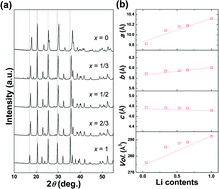Thermal structural stability of a multi-component olivine electrode for lithium ion batteries†
Abstract
Olivine electrodes have been extensively studied as an important class of cathode materials for lithium-ion batteries. Although LiFePO4 has shown promise as a low-cost and high-power electrode thereby leading to its commercialization, recently, binary and ternary olivines such as Li(Fe,Mn,Co)PO4 have also been considered as alternatives to overcome the low operating voltage and low energy density of LiFePO4. Herein, we investigate the structural evolution of Li(Mn1/3Fe1/3Co1/3)PO4, which is a promising multi-component olivine cathode material, using combined in situ high-temperature X-ray diffraction and flux neutron diffraction analyses at various states of charge. The phase stability map of the electrode shows that delithiation/lithiation occurs via a one-phase reaction from room temperature to ∼500 °C with excellent thermal stability. Maximum entropy method analysis reveals anisotropic lattice expansion along each lattice direction at elevated temperature, which corresponds well with the lattice variations observed upon delithiation in the electrochemical cell.

- This article is part of the themed collection: Crystal engineering of composite materials

 Please wait while we load your content...
Please wait while we load your content...